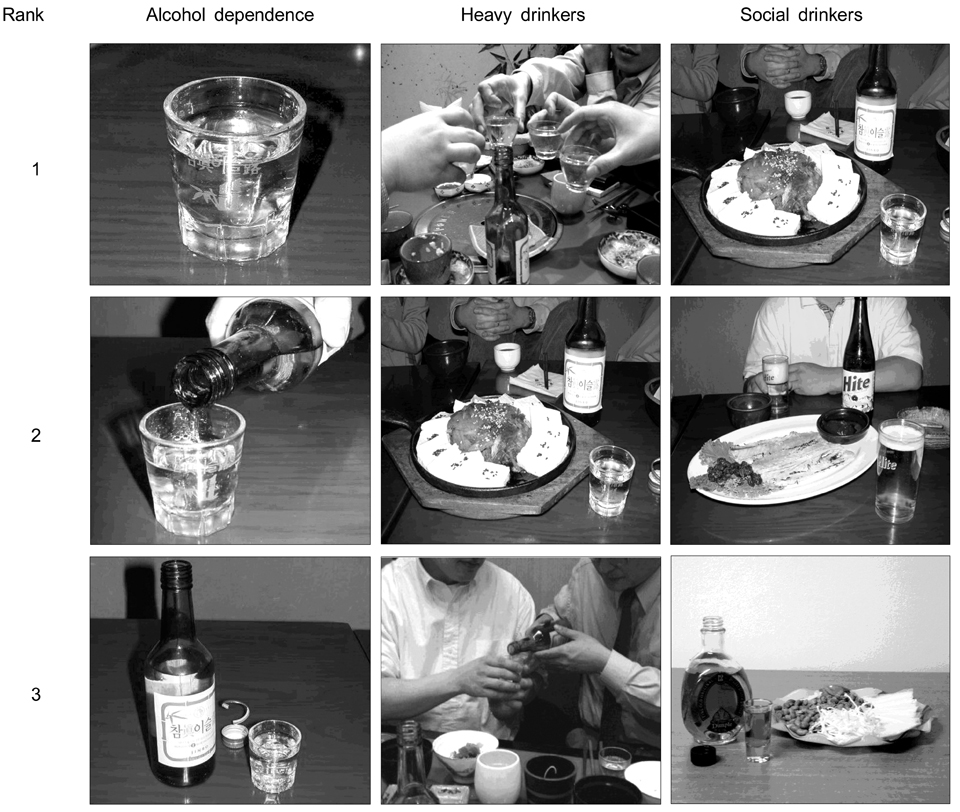Yonsei Med J.
2006 Aug;47(4):491-497. 10.3349/ymj.2006.47.4.491.
Differences of Photographs Inducing Craving Between Alcoholics and Non-alcoholics
- Affiliations
-
- 1Department of Psychiatry, Yonsei University College of Medicine, Seoul, Korea. keen@yumc.yonsei.ac.kr
- 2Department of Psychiatry, National Health Insurance Corporation Ilsan Hospital, Gyeonggi-do, Korea.
- KMID: 1779498
- DOI: http://doi.org/10.3349/ymj.2006.47.4.491
Abstract
- Many researchers have used cue reactivity paradigm to study alcohol craving. But the difference of craving response to drinks between alcoholic patients and social drinkers was little evaluated. To investigate characteristics of alcohol-related visual cues which induce alcohol craving in alcoholism, we examined the response of subjects to alcohol-related cues considering qualitative aspects. The authors developed 27 photographs related to alcohol as candidate visual cues. Thirty five patients with alcohol dependence, 35 heavy drinkers and 35 social drinkers were shown these pictures and asked to rate these 6 pictures in order of inducing alcohol craving the most. 'A glass of Soju' and 'A Party scene' were chosen as the alcohol-related visual cues which induced craving the most in the patients and heavy drinkers, respectively. The results suggest that the patients with alcohol dependence are more absorbed by alcohol without drinking context such as an atmosphere or situation involving drinking. Heavy drinkers may experience craving in anticipation of being in a drinking situation.
Keyword
MeSH Terms
Figure
Reference
-
1. Modell JG, Mountz JM. Focal cerebral blood flow change during craving for alcohol measured by SPECT. J Neuropsychiatry Clin Neurosci. 1995. 7:15–22.2. George MS, Anton RF, Bloomer C, Teneback C, Drobes DJ, Lorberbaum JP, et al. Activation of prefrontal cortex and anterior thalamus in alcoholic subjects on exposure to alcohol-specific cues. Arch Gen Psychiatry. 2001. 58:345–352.3. Schneider F, Habel U, Wagner M, Franke P, Salloum JB, Shah NJ, et al. Subcortical correlates of craving in recently abstinent alcoholic patients. Am J Psychiatry. 2001. 158:1075–1083.4. Wrase J, Grusser SM, Klein S, Diener C, Hermann D, Flor H, et al. Development of alcohol-associated cues and cue-induced brain activation in alcoholics. Eur Psychiatry. 2002. 17:287–291.5. Edwards G, Gross MM. Alcohol dependence: provisional description of a clinical syndrome. BMJ. 1976. 1:1058–1061.6. Jellinek EM. The craving for alcohol. Q J Stud Alcohol. 1955. 16:35–38.7. Marlatt GA. Marlatt GA, Gordon JR, editors. Cognitive factors in the relapse process. Relapse Prevention. 1985. New York: Guilford Press;128–200.8. Lowman C, Hunt WA, Litten RZ, Drummond DC. Research perspectives on alcohol craving: an overview. Addiction. 2000. 95:Suppl 2. S45–S54.9. Childress AR, Mozley PD, McElgin W, Fitzgerald J, Reivich M, O'Brien CP. Limbic activation during cue-induced cocaine craving. Am J Psychiatry. 1999. 156:11–18.10. Herrmann MJ, Weijers HG, Wiesbeck GA, Aranda D, Boning J, Fallgatter AJ. Event-related potentials and cue-reactivity in alcoholism. Alcohol Clin Exp Res. 2000. 24:1724–1729.11. Tapert SF, Cheung EH, Brown GG, Frank LR, Paulus MP, Schweinsburg AD, et al. Neural response to alcohol stimuli in adolescents with alcohol use disorder. Arch Gen Psychiatry. 2003. 60:727–735.12. Ludwig AM, Wikler A. "Craving" and relapse to drink. Q J Stud Alcohol. 1974. 35:108–130.13. Drummond DC, Tiffany ST, Glaudier SP, Remington B. Addictive behavior: cue exposure theory and practice. 1995. Chichester: John Wiley & Sons.14. American Psychiatric Association. Diagnostic and statistical manual of mental disorders. 1994. 4th ed. Washington, DC: American Psychiatric Press.15. National Institute on Alcohol Abuse and Alcoholism. NIH Publication No. 95-3769. The physicians' guide to helping patients with alcohol problems. 1995. Bethesda, MD: Department of Health and Human Services.16. Jajodia A, Earleywine M. Measuring alcohol expectancies with the implicit-association test. Psychol Addict Behav. 2003. 17:126–133.17. Stein KD, Goldman MS, Del Boca FK. The influence of alcohol expectancy priming and mood manipulation on subsequent alcohol consumption. J Abnorm Psychol. 2000. 109:106–115.18. Schulze D, Jones BT. The effects of alcohol cues and an alcohol priming dose on a multi-factorial measure of subjective cue reactivity in social drinkers. Psychopharmacology. 1999. 145:452–454.19. Wiers RW, van Woerden N, Smulders FT, de Jong PJ. Implicit and explicit alcohol-related cognitions in heavy and light drinkers. J Abnorm Psychol. 2002. 111:648–658.20. Anton RF. What is craving? Models and implications for treatment. Alcohol Res Health. 1999. 23:165–173.21. Chung IW, Hong JB, Lee SI, Kim H, Son JW. Clinical characteristics and gene polymorphisms of aldehyde dehydrogenase II and arylsulfatase A in hospitalized patients with alcohol dependence. J Korean Acad Addict Psychiatr. 2000. 4:93–101.22. Carter BL, Tiffany ST. Meta-analysis of cue-reactivity in addiction research. Addiction. 1999. 94:327–340.23. Tiffany ST, Carter BL, Singleton EG. Challenges in the manipulation, assessment and interpretation of craving relevant variables. Addiction. 2000. 95:Suppl 2. S177–S187.
- Full Text Links
- Actions
-
Cited
- CITED
-
- Close
- Share
- Similar articles
-
- Development of the Alcohol-Related Visual Stimuli Inducing Alcohol Craving
- A Study of Personality Disorders in Alcoholics
- A Cross-cultural Study of Alcoholism in Korean, Yanbian Korean-Chinese, and Yanbian Chinese Alcoholics
- A clinical study of female alcoholics admitted to a mental hospital
- A preliminary study of various variables of alcoholic patients influenced on the participation in alcoholics anonymus


